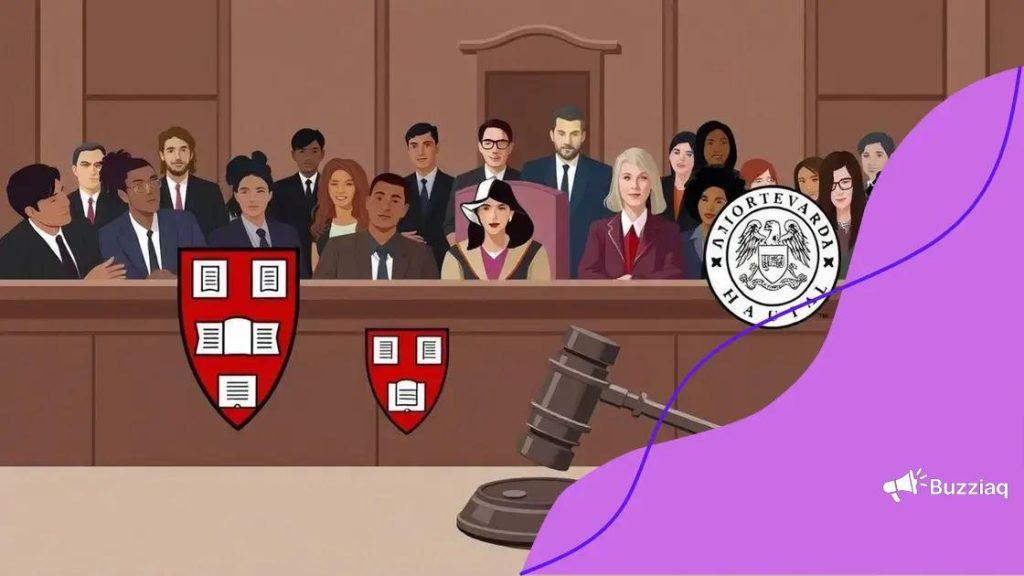Harvard’s legal battle against federal funding cuts

AD
Harvard’s legal battle against federal funding cuts highlights significant challenges, potentially leading to higher tuition and reduced resources, while universities adapt by seeking alternative funding sources and partnerships.
Harvard’s legal battle against federal funding cuts has become a focal point in discussions about educational finance and institutional independence. What does this mean for students and academics alike? Let’s unpack the details.
AD
Overview of Harvard’s funding structure
Harvard University has a complex funding structure that plays a crucial role in maintaining its operations and academic excellence. Understanding the key components of this structure helps to shed light on the current legal battle over federal funding cuts.
In general, Harvard’s funding comes from various sources that contribute to its financial sustainability. Here are the primary sources:
Key Sources of Funding
Harvard’s budget comprises a blend of income that supports diverse programs and initiatives. This includes:
AD
- Tuition and Student Fees: A significant part of the university’s revenue is generated from tuition paid by students.
- Endowment Income: Harvard has one of the largest endowments in the world, providing substantial annual support for operations.
- Research Grants: The university secures funding through grants awarded for various research projects, often from federal agencies.
- Donations: Alumni and other benefactors contribute to Harvard through donations and fundraising efforts.
Each of these funding sources contributes to different aspects of university operations, from faculty salaries to campus infrastructure. For instance, the endowment plays a vital role in providing financial aid, ensuring that students from all backgrounds can access a Harvard education.
Impact of Federal Funding
Federal funding also represents a significant portion of the financial landscape for Harvard. This funding is crucial for supporting research initiatives and educational programs. However, recent cuts have raised questions about the sustainability of these endeavors. The reduction in federal support not only affects funding levels but also changes how universities can allocate resources. As Harvard navigates its legal battle, understanding its funding structure becomes more critical.
In summary, Harvard’s funding structure is multifaceted and intricately linked to its goals and mission. Each source of funding, from tuition to federal grants, establishes a framework that supports the university’s operations. The ongoing legal challenges related to federal funding cuts may reshape this framework, making it essential for universities to assess their dependencies and strategize for the future.
Key reasons behind the federal funding cuts
The federal funding cuts impacting Harvard University stem from various policy changes and economic factors. Understanding these reasons is essential to comprehend the broader implications for higher education.
One significant reason for these cuts is the shift in federal budget priorities. Over the years, the government has focused on reducing the national deficit, which has led to decreased discretionary spending. This includes financial support for university programs and research initiatives. As a result, institutions like Harvard face challenges in securing the necessary funding for their operations.
Policy Changes
Various policy changes have also contributed to the reduction in funding. For instance, legislative shifts have led to an emphasis on accountability and performance metrics. Funding has increasingly been tied to specific outcomes, which can disadvantage institutions that serve diverse student populations.
- Increased Scrutiny: Federal funding is scrutinized more closely than before, affecting how resources are allocated.
- Performance-Based Funding: Many programs now require schools to meet certain performance criteria to receive funding.
- Less Grant Availability: Limited federal grants for research mean fewer opportunities for universities to support their academic endeavors.
Additionally, the impact of economic downturns cannot be overlooked. Financial crises often lead to budget constraints at the federal level, prompting cuts across various sectors, including education. Harvard and other universities must navigate these challenges while striving to maintain high academic standards and support for their students.
Furthermore, heightened competition among universities for limited resources has created an environment where institutions are constantly adjusting their strategies for funding. As funding sources become scarcer, research universities like Harvard must adapt, focusing on alternative funding opportunities, such as private donations and partnerships.
Legal implications of the lawsuit

The legal implications of the lawsuit involving Harvard and federal funding cuts are profound and far-reaching. This case not only addresses immediate financial concerns but also raises important questions about the future of university funding in the United States.
The lawsuit highlights the balance between federal authority and university autonomy. Institutions like Harvard argue for their right to secure funding essential for research and education. On the other hand, the government has been emphasizing accountability in spending. This creates a conflict on how federal monies should be managed.
Impact on Federal Funding Policies
The outcome of this lawsuit could reshape how federal funding is allocated to universities. If the court rules in favor of Harvard, it may set a precedent affirming the rights of educational institutions to challenge funding cuts. This could lead to increased scrutiny and potential changes in federal funding policies for higher education.
- Accountability Standards: A ruling in Harvard’s favor may push the government to revise its accountability measures for fund distribution.
- Increased Funding Opportunities: A successful challenge could lead to more consistent funding levels for universities nationwide.
- Broader Implications: This case may inspire other universities facing similar funding cuts to pursue legal action, further complicating federal funding strategies.
Moreover, the legal implications extend to students. A loss could result in higher tuition and reduced services, impacting the affordability of higher education. Many students rely on federal funding for scholarships and grants. Therefore, any cuts could have significant effects on their academic opportunities.
In addition, increased legal challenges could create a more contentious environment between universities and the federal government. This might lead to ongoing disputes over funding and regulation, affecting the relationship between higher education institutions and policymakers.
Potential impacts on students and faculty
The potential impacts of federal funding cuts on students and faculty at Harvard can be significant and wide-ranging. These cuts threaten not only the financial stability of the university but also the quality of education and resources available to its community.
For students, decreased funding could lead to higher tuition rates. Many students rely on financial aid to cover their expenses, and funding cuts may reduce the availability of scholarships and grants. This could make attending Harvard less accessible to low- and middle-income students, affecting diversity and inclusion within the student body.
Impacts on Academic Programs
Federal funding cuts can also affect academic programs directly. Reduced financial resources may lead to:
- Course Reductions: Certain programs and courses might be cut, limiting student choices and altering the educational experience.
- Loss of Faculty Positions: Funding cuts could force Harvard to consider layoffs or hiring freezes, impacting faculty morale and student support.
- Research Limitations: Without sufficient federal funding, research opportunities may dwindle, affecting faculty and student projects alike.
Additionally, available support services could be reduced. Many students depend on tutoring, mental health services, and academic advising to succeed. Cuts to these services might create challenges for students as they navigate their academic journeys.
For faculty, funding cuts may limit professional development opportunities and resources necessary for teaching. Without appropriate funding, faculty members may struggle to access research materials or engage in innovative teaching practices. This can diminish the overall quality of education offered at the university.
Moreover, faculty-student relationships could be affected. Faculty members may face increased workloads due to fewer resources, which can impact their availability and support for students. The potential for strained interactions can hinder the rich learning environment that Harvard aims to provide.
Future of university funding in the U.S.
The future of university funding in the U.S. is evolving rapidly, influenced by various economic, political, and social factors. As schools like Harvard navigate funding challenges, understanding these changes is crucial for students, faculty, and policymakers alike.
One major trend is the shift toward alternative funding sources. With federal support decreasing, many universities are looking to private donations, partnerships with businesses, and innovative funding models. These alternative sources not only provide financial support but also encourage collaboration between educational institutions and industry.
Growing Importance of Private Funding
Private funding will likely play a larger role in how universities operate and grow in the future. This shift may lead to:
- Increased Philanthropy: A focus on cultivating relationships with alumni and donors to secure financial support.
- Corporate Partnerships: Collaborations with businesses that offer funding in exchange for access to research and talent.
- Grant Opportunities: More emphasis placed on applying for grants from non-profit organizations and private foundations.
Additionally, universities may adopt more entrepreneurial approaches to funding. This could involve developing new programs or services that generate revenue. Online education, for instance, has become a significant area for growth, allowing institutions to reach a broader audience and diversify their income sources.
Moreover, the conversation around funding equity is gaining momentum. There is increasing awareness that public funding should be more equitably distributed among schools, especially those serving underrepresented communities. Advocates argue for policies that ensure all universities receive the support needed to provide quality education.
As we look toward the future, it is clear that universities must adapt to the changing landscape of funding. The ability to innovate and explore new financial avenues will be essential for maintaining educational excellence and access for all students.
In conclusion, the ongoing legal battle over federal funding cuts at Harvard highlights critical issues affecting the future of university funding in the U.S. As federal support decreases, universities are forced to explore new funding sources and strategies. This shift could lead to greater reliance on private funding and innovative revenue-generating programs. It’s essential for universities to adapt and ensure equitable access to education for all students. By embracing changes and collaborating with various stakeholders, institutions can navigate these challenges and continue to provide quality education.
FAQ – Frequently Asked Questions about Harvard’s legal battle and federal funding cuts
What is the main issue in Harvard’s legal battle regarding federal funding?
The main issue revolves around federal funding cuts that threaten the financial stability and educational resources available at Harvard University.
How could federal funding cuts impact students?
Federal funding cuts could lead to higher tuition rates and reduced availability of scholarships, making education less accessible for many students.
What are the potential long-term effects on university funding in the U.S.?
Long-term effects may include greater reliance on private funding, changes in funding equity, and increased competition among universities for resources.
How can universities adapt to these funding challenges?
Universities can adapt by exploring new funding opportunities, forming partnerships with businesses, and innovating educational programs to generate revenue.